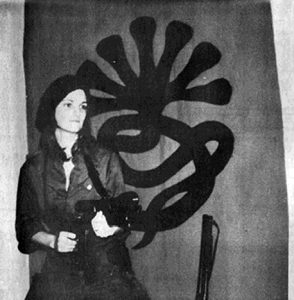01.30
This week (January 30 – February 5) in crime history – Mohandas Gandhi was assassinated (January 30, 1948); Andrew Jackson narrowly escaped assassination (January 30, 1835); Prosecutors announce intention to retry Ray Buckey in the McMartin Preschool molestation case (January 31, 1990); Guy Fawkes kills himself moments before his execution (January 31, 1606); Ted Bundy murdered University of Washington student (February 1, 1974); King Carlos I of Portugal and his heir were assassinated (February 1, 1908); Murder of Hollywood director William Desmond Taylor February 2, 1922); Barnett Davenport committed mass murder in rural Connecticut (February 3, 1780); Patty Hearst was kidnapped (February 4, 1974); Medger Evers assassin was convicted (February 5, 1994)
Highlighted Crime Story of the Week –

On February 4, 1974, Patricia Hearst, granddaughter daughter of publisher William Randolph Hearst, was kidnapped from her Berkeley, California, apartment. Stephen Weed, Hearst’s fiancé, was beaten unconscious by the two abductors. Soon, a ransom demand came from the Symbionese Liberation Army (SLA), a radical activist group led by Donald DeFreeze.
DeFreeze had formed the SLA in 1973 after he escaped from prison. About two years before Hearst’s kidnapping, an SLA bomb-making factory had been discovered by the police. On November 6, 1973, the SLA shot and killed Marcus Foster, Oakland’s superintendent of schools, with bullets laced with cyanide.
The SLA instructed Hearst’s father to distribute $70 in food for ever poor person from Santa Rosa to Los Angeles. Hearst agreed to give away $2 million to the poor in Oakland. The Black Muslims, Malcolm X’s former organization, were chosen to manage the food distribution, which turned into a riot when more than 10,000 people showed up and fought for the food. Afterwards, the SLA demanded an additional $6 million giveaway. Hearst refused and they did not release Patty.
The Hearst story took a strange and unexpected turn two months after the abduction, when the SLA robbed the Hibernia Bank in San Francisco. The surveillance cameras clearly showed that Patty Hearst was one of the machine gun-toting robbers. Soon after followed a taped message from the SLA in which Hearst claimed that she had voluntarily joined the SLA and was now to be known as “Tania.”
On May 17, 1974, police were tipped that the SLA leaders were at a Los Angeles home. With 400 police and FBI agents outside the house, a tremendous gun battle broke out. The police threw gas canisters into the house and then shot at them, sparking a fire in which DeFreeze and five other SLA members died. However, Hearst was not inside the house. She was not found until September 1975.
Patty Hearst was put on trial for armed robbery and convicted, despite her claim that she had been coerced, through repeated rape, isolation, and brainwashing, into joining the SLA. Prosecutors believed that she actually orchestrated her own kidnapping because of her prior involvement with one of the SLA members. Despite any real proof of this theory, she was convicted and sent to prison. President Carter commuted Hearst’s sentence after she had served almost two years. Hearst was pardoned by President Clinton in January 2001.
Check back every Monday for a new installment of “This Week in Crime History.”
Michael Thomas Barry is a columnist for www.crimemagazine.com and is the award winning author of seven nonfiction books that includes In the Company of Evil: Thirty Years of California Crime, 1950-1980.











